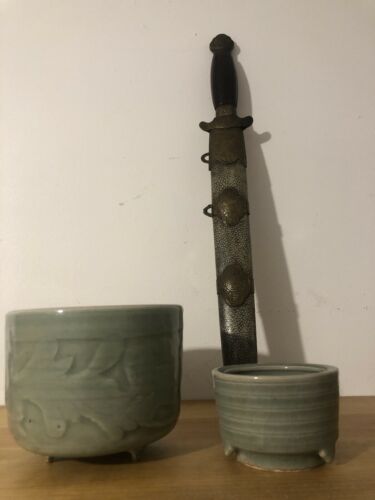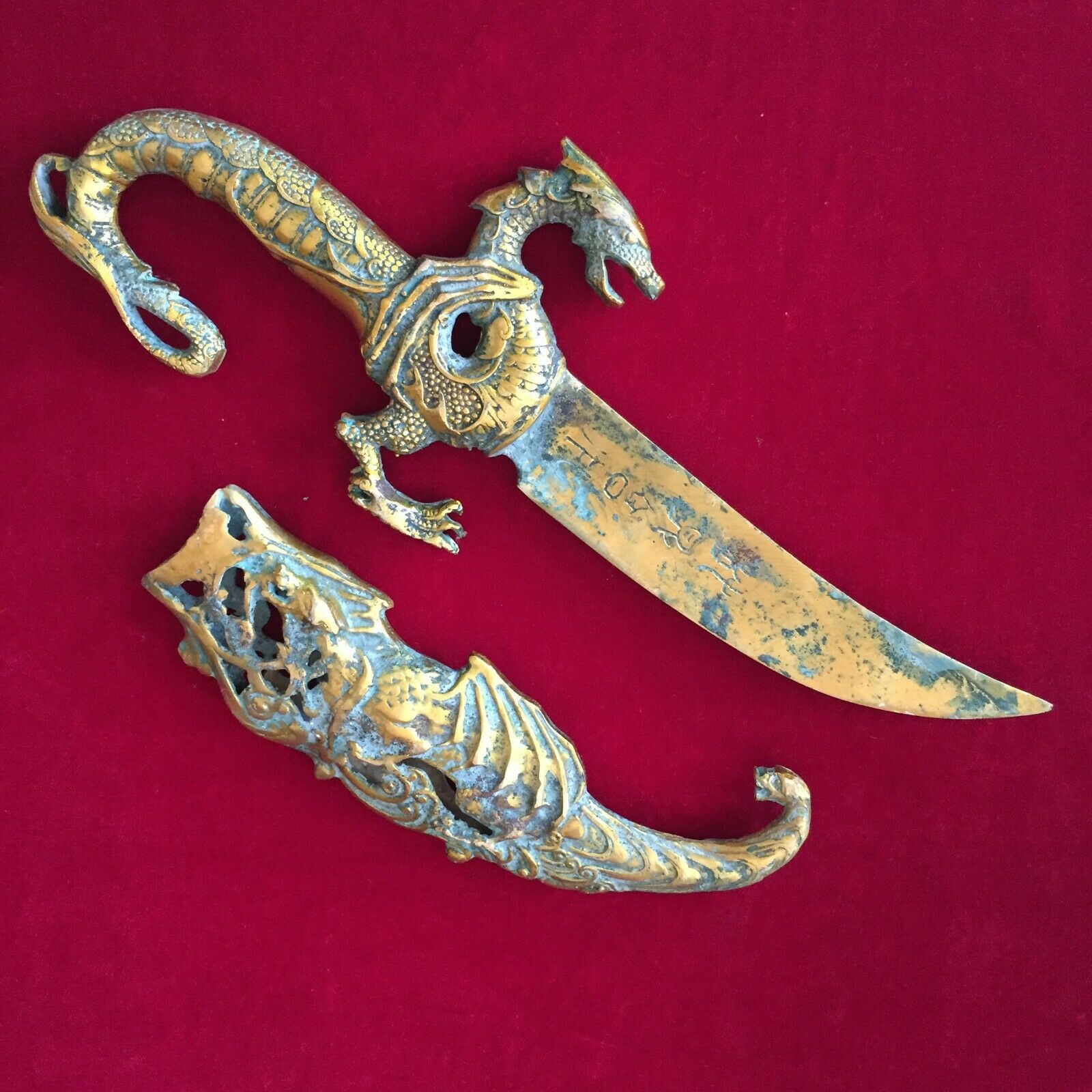-40%
Chinese Warring States Jade Scabbard Slide for Sword: Inscription & Translation
$ 8712
- Description
- Size Guide
Description
ANCIENT CIVILIZATIONSArtifacts, Antiques, & Fine Collectables
Chinese Jade Scabbard Slide for Sword
With Nine Etched & Pecked Pictographs
Warring States Period
c. 475 BC—221 BC
NOTE:
William D. Houghton, the President of ANCIENT CIVILIZATIONS
, a State of Washington Licensed Business,
assumes all responsibility for the information contained in this description and for the English translation and transcription of the ancient Chinese graphic characters.
Furthermore, I prohibit the further dissemination of this information in any written, video, or electronic format without my expressed, written approval.
Thank You!
NOTE:
All items offered for sale by Ancient Civilizations are unconditionally guaranteed authentic. They were legally imported to the United States years ago and are legal to sell and own under U.S. Statute Title 19, Chapter 14, Code 2611, Convention on Cultural Property.
SUMMARY
Item:
Chinese Jade Scabbard Slide for Sword
Dynasty:
Warring States Period c. 475 BC—221 BC
Material:
Nephrite jade: translucent, cream-colored, & highly polished
Approximate Measurements
·
Length:
3.98” (101mm)
·
Width:
.72” (18mm)
·
Height:
.58” (15mm)
Condition:
Very good museum quality with correct jade patina.
Most of the mineral deposits and micro-crystalline jade in the cut lines has been professional removed by the previous owner in China. Although not normally recommended, this conservation does expose the beauty of the jade slide and allows us to transcribe and translate some of the small, pictographic symbols/characters that are some of the earliest written language ever used in Neolithic China some 2,200-years-ago.
Further antiquity evidence includes:
calcification and nine, early Chinese characters that could only be found on authentic and original Neolithic Chinese ritual jades.
Provenance/History:
Formerly in a private family collection in China for nearly 65 years.
This jade slide has never been exhibited anywhere in the world or has the symbolic meaning revealed and some of the nine (9) pictographic characters translated until it was acquired by this author.
The slide is now part of a private collection in the State of Washington.
DETAILS
This beautifully carved, jade scabbard slide is made of translucent, cream-colored jade and dates to the China’s Warring States Period (475 BC—221 BC).
It was one of four standard jade ornaments that were first introduced in China over 2,200-years-ago.
The four standard pieces of jade incorporated in the metal (either bronze or iron) sword are as follows:
·
Pommel:
This top-most part on the iron sword was a small, circular disc that was usually decorated with carved designs of dragons or tadpole curls.
·
Hilt:
This jade ornament slides down the bronze handle spindle to rest against the upper termination of the blade.
·
Scabbard Slide:
This rectangular-shaped object was attached to the wood or lacquered scabbard, and allowed the sword to be attached to the belt of its owner that fit inside the closed, boxed-in portion of the jade slide.
·
Chape:
And finally, at the very, lower, tip of the scabbard, was the jade chape, that would prevent the wooden scabbard from scraping the ground.
The use of jade for sword and scabbard fittings started in the Warring States period and continued throughout the Qin and Han Dynasties and into the succeeding Six Dynasties period.
Many of these sword and scabbard fittings were beautifully carved by master craftsmen that were employed by the elite-class and imperial families.
This jade scabbard slide would have been bound into the scabbard with silk cord, so that the inner surface of the rectangular lower section was level with the surface of the scabbard and the long tail section was facing in the direction of the sword’s pommel.
The cut lines on the outside surface of the jade slide were cut with a low RPM, spinning disk that was foot powered. The cut lines are period correct and show no signs of modern, high-speed, metal tools.
{See photo # 4.}
PICTOGRAPHS
NOTE:
William Houghton, the President of ANCIENT CIVILIZATIONS
, a State of Washington Licensed Business, assumes all responsibility for the information contained in this description and for the English translation and transcription of the ancient Chinese graphic characters.
Furthermore, I prohibit the further dissemination of this information in any written, video, or electronic format without my expressed, written approval.
Thank You!
On the underside and on one side of the scabbard slide, there appear to be nine (9) ancient pictographs that have been percussively pecked, etched, and painted on the jade slide over 2,200-years-ago.
Three of the images/characters were etched into the jade, while the remaining six characters appear to have been painted on and now show up on the jade as a light tan color.
These tiny characters were not meant to be read by human eyes, but rather were only suitable for the sacred eyes of the gods and ancestors.
I have translated into English the larger ones and those that I can see clearly enough.
{See my detailed translation below.}
·
The two clearest characters are those of a Son killing an animal that appears to have horns and was likely an ox.
The two characters are only about .68” (17mm) long and show the standing Son holding a sword or flint axe that was commonly used to sacrifice beasts at ritual ceremonies.
The animal is pictured lying down with its neck slit by the Son’s sword/axe.
{See macro photos # 6-8, blue arrow points to the Son with a sword or flint axe in his right hand.}
·
On the underside of the slide, there is the second image of a kneeling man (likely another Son) who is about .59” (15mm) tall.
He appears to be holding a curved, flint knife in his left hand that he has used to sacrifice another animal, this time a smaller one that is shown to his left.
A very tiny <1mm tall grandson (that looks like a frog) is shown below his feet. {
See macro photo # 10 with colored arrows and notations.}
·
Also, on the underside of the slide to the right of the above character, there is the image of a long animal 1.23” (33mm) that is likely a Dragon.
He stretches over one of the cut lines in the slide.
{See macro photo # 11.}
·
A tiny pictograph only 6.5mm long on the surface that stretches another 6.5mm down into the cut area where the sword would have rested inside the slide.
I cannot identify this character.
{
See macro photo # 9.}
·
On the underside of the slide, there are three characters that have been etched into the slide in a vertical column.
The lowest character is a kneeling man, who was likely a servant.
I was not able to identify the other two characters.
{See macro photo # 12.}
REFERENCES:
The Great Bronze Age of China
:
An Exhibition from the People’s Republic of China
, edited by Wen Fong, 1980
Metropolitan Museum of Art, 1980.
Ancient Chinese Warfare
, Ralph D. Sawyer, Mei-chün Sawyer
Archaeology
, Archaeological Institute of America, Feb/March 2015
Shanghai Museum
British Museum
Museum of Chinese History, Beijing
China Online Museum
British Museum
Rawson, Jessica.
Chinese Jade from the Neolithic to the Qing
. London: British Museum, 1995.
Smithsonian Museum, Sackler & Freer Gallery, WDC
MET, New York
Please see photos for details as they are part of the description. Thank You!
Bid with confidence--as I have Positive Feedback from hundreds of satisfied customers from around the world!
International Buyers are responsible for all import taxes, duties, and shipping.
No
international returns. Thank You!
Please look carefully at the photos, taken with 4x macro lens, since they are part of the description.
It
would make a
wonderful
addition to your collection or a Super gift!
The stand
, AA battery,
and the ruler are not part of the auction, just there to give you a perspective and a good view of item.
And please ask any questions before you buy.
Thanks!




















